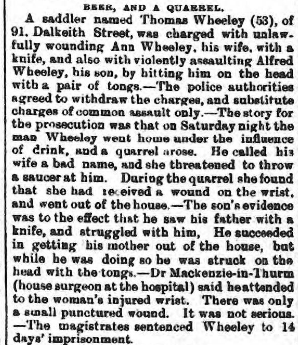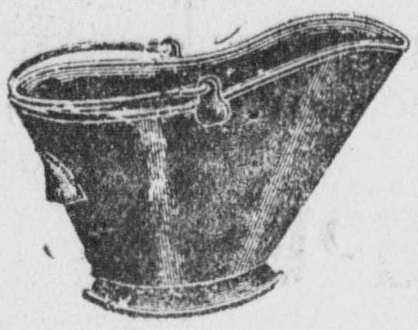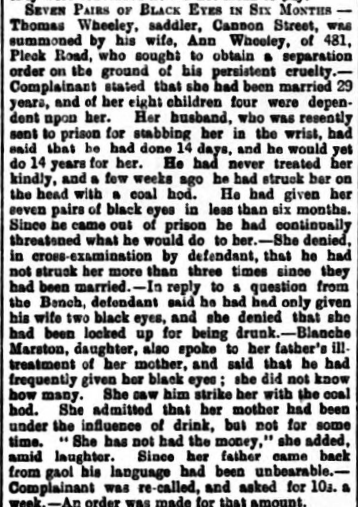In 1901, Thomas Henry WHEELEY and Ann ROGERS had been married for 23 years and had had 8 children together. They were living on Dalkeith Street in Walsall – a row of terraced houses built alongside the Walsall Locks less than ten years before (in the early 1890s). Thomas was a ‘brown saddler’ living in “a poor locality” so life was probably not easy for the family.

On Saturday the 20th May, 1905 – only a few years after the census was taken – the family had ‘a quarrel’. Thomas who had been out drinking, came home and argued with Ann, calling her names. Ann, in turn, threatened to throw a saucer at him and Thomas attacked her with a knife. Their 18-year-old son, George Alfred, seeing this take place, struggled with his father and was subsequently hit on the head with some tongs [Not sure if these would be saddler tongs or coal tongs or another type). Ann had managed to escape the house during the scuffle and discovered she had been cut on the wrist.

BEER, AND A QUARREL.
A saddler named Thomas Wheeley (53), of 91, Dalkeith Street, was charged with unlawfully wounding Ann Wheeley, his wife, with a knife, and also with violently assaulting Alfred Wheeley, his son, by hitting him on the head with a pair of tongs. -The police authorities agreed to withdraw the charges, and substitute charges of common assault only. -The story for the prosecution was that on Saturday night the man Wheeley went home under the influence of drink, and a quarrel, arose. He called his wife a bad name, and she threatened to throw a saucer at him. During the quarrel she found that she had received a wound on the wrist, and went out of the house. -The son’s evidence was to the effect that he saw his father with a knife, and struggled with him. He succeeded in getting his mother out of the house, but while he was doing so he was struck on the head with the tongs. -Dr Mackenzie-in-Thurm (house surgeon at the hospital) said he attended to the woman’s injured wrist. There was only a small punctured wound. It was not serious. -The magistrates sentenced Wheeley to 14 days’ imprisonment. (Walsall Advertiser 27 May 1905 p6 c7)
I find it interesting that “the police authorities agreed to withdraw the charges, and substitute charges of common assault only”. Who requested the charges be withdrawn/substituted? Common assault is a lesser charge than ‘unlawfully wounding’ or ‘violently assaulting’ [source] and so appears to minimise Thomas’ actions. Was the switch to a lesser charge because: a) there was a lack of evidence of more serious injuries; b) prosecution were more likely to secure a conviction this way; or c) the general view that domestic violence was less serious?
Thomas’ two-week stint in prison for the assaults seemed to have little effect. A few weeks later, the couple were living at separate addresses – Thomas on Cannon Street and Ann at 481 Pleck Road – when Ann requested a separation order to support her and their four remaining dependent children – Sidney, Ernest, Grace Hilda and Maria (whose ages ranged from 14 to 7).

PERSISTENT CRUELTY.
Thomas Henry Wheeley, Cannon Street, was summoned for persistent cruelty to his wife, who applied for an order against him. -Complainant stated that she had been obliged to leave her husband because of his persistent cruelty. She had been married 29 years and had eight children, four of which were depending upon her. Her husband had assaulted her several times and was always threatening her. She had had seven pair of black eyes in less than three months. -The Chairman (to defendant): How many black eyes have you given her since you were married? -Two, that’s all sir. -An order for 10s a week was eventually made. (Walsall Advertiser 24 June 1905 p2 c5-6)
In 1895, the ‘Summary Jurisdiction (Married Women) Act’ was introduced. It allowed married women to apply to the magistrates’ courts for separation and maintenance orders if their husbands had:
i. been convicted of an aggravated assault under S.43 of the Offences Against The Persons Act 1861
ii been convicted on indictment for assault and sentenced to at least two months imprisonment or fined £5
iii. deserted them
iv. been guilty of persistent cruelty so as to make their wives leave home.
v. wilfully neglected to maintain so as to cause their wives to leave home.(Radford, M. T. (1988) The law and domestic violence against women. PhD Thesis. University of Bradford. Available from: https://bradscholars.brad.ac.uk/handle/10454/3875 (Accessed: 13 May 2020), page 38)
Ann applied for an order of separation on the grounds of his persistent cruelty and subsequent articles definitely paint a picture of an unhappy marriage marred with ‘persistent cruelty’ and alcohol abuse.

Ann told the court that her husband had ‘never treated her kindly’ and that she had had ‘seven pair of black eyes in less than three months’. Thomas denied this and claimed he had ‘only’ given her two and struck her ‘no more than three times’. Ann also claimed that Thomas had hit her on the head with a coal hod – a claim supported by their 25 year old daughter, Blanche who witnessed the incident. Blanche also confirmed that her father had ‘frequently’ given her mother black eyes. However she also said that her mother had also ‘been under the influence of drink’ but this had not been for some time since “she has not had the money”.

SEVEN PAIRS OF BLACK EYES IN SIX MONTHS –
Thomas Wheeley, saddler, Cannon Street, was summoned by his wife, Ann Wheeley, of 481, Pleck Road, who sought to obtain a separation order on the ground of his persistent cruelty. -Complainant stated that she had been married 29 years, and of her eight children four were dependent upon her. Her husband, who was resently [sic] sent to prison for stabbing her in the wrist, had said that he had done 14 days, and he would yet do 14 years for her. He had never treated her kindly, and a few weeks ago he had struck her on the head with a coal hod. He had given her seven pairs of black eyes in less than six months. Since he came out of prison he had continually threatened what he would do to her. -She denied, in cross-examination by defendant that he had not struck her more than three times since they had been married. -In reply to a question from the Bench, defendant said he had only given his wife two black eyes, and she denied that she had been locked up for being drunk. -Blanche Marston, daughter, also spoke to her father’s ill-treatment of her mother, and said that he had frequently given her black eyes; she did not know how many. She saw him strike her with the coal hod. She admitted that her mother had been under the influence of drink, but not for some time. “She has not had the money,” she added, amid laughter. Since her father came back from gaol his language had been unbearable. -Complainant was re-called, and asked for 10s. a week. -An order was made for that amount. (Walsall Observer, and South Staffordshire Chronicle 24 June 1905 p2 c5)
Despite the 1895 act, it’s clear that domestic violence was still not regarded as seriously as it should. Thomas’ seemingly casual, or even blasé attitude regarding the violence he actually admits to inflicting on his wife indicates that beating your wife was largely seen as ‘fine’ depending on its regularity or severity. A woman’s options were very limited and there were many reasons a wife would remain with an abusive husband – whether financial, emotional or social.
For whatever reasons, Thomas and Ann were together again by the 1911 census.

I was completely unaware of the events of 1905 until recently. Thomas and Ann appeared in every census together since their marriage in 1878 (1881-1911) so I didn’t expect there to have been such a rift. We like or want to believe that the families we research lived peacefully together despite their often difficult lives. My discovery of these newspaper articles reminded me this is often not the case.
The census is only a ‘snapshot’ every ten years – it’s important to remember this. A lot can happen between these ‘snapshots’. Just as living at the same address two censuses in a row doesn’t always mean they’d actually been there all that time, a family simply living together does not always mean their lives were harmonious all that time.
This family is also featured in Wheeley Interesting and Wheeley Interesting Sequel.
